Scene
Saying it Like "Indians": The Wooster Group's Cry Trojans!, Sa(l)vage Ethnography, and the Politics of "Playing Injun"
by Gavin Hollis. Written on 2015-04-07. Published in 2017 Issue 1.
For the production
![]() Cry Trojans! (2015, The Wooster Group, USA)
Cry Trojans! (2015, The Wooster Group, USA)
“We arenʼt degrading the Indians, we are participating in a tradition of this team,” said John Brittain, 71, who came to the game wearing a feathered headdress and claimed to being one-fourth Apache. “Part of me being a fan is to wear Indian gear, and that is honoring the Native Americans.” The Guardian, April 12, 2015
The bulk of the white people who live in contact with the Indian today would like to see this Red brother exterminated; not only for the sake of grabbing his land, but because of the silent, invisible, but deadly hostility between the spirit of the two races. The minority of whites intellectualize the Red Man and laud him to the skies. But this minority of whites is mostly a high-brow minority with a big grouch against its own whiteness. So there you are.” D.H. Lawrence, Studies in Classic American Literature, 1923
“Itʼs a good day to be indigenous.” Randy Peone, in Smoke Signals, directed by Chris Eyre, screenplay by Sherman Alexie, 1998
In 2012, as part of the World Shakespeare Festival, The Wooster Group and the Royal Shakespeare Company collaborated on a production of Troilus and Cressida in Stratford-upon-Avon and London, with the former playing Trojans and the latter the Greeks. The two companies rehearsed separately, coming together three weeks before previews to suture their two approaches. The result, by common consensus, was a mess—the RSC is hardly known for experimentalism, the Wooster Group is known for nothing but; the RSC produces polished (if not always all that interesting) productions, while the Wooster Group revels in the show of its seams. To quote Michael Billington, “the union prove[d] strangely infertile ... less a collaboration than an awkward stylistic collision.” As Thomas Cartelli notes, “To say that a great many auditors greatly disliked the Woosterʼs Groupʼs share of their RSC collaboration would be a vast understatement, ‘appallingʼ or ‘awfulʼ being the preferred adjective even among (especially among) the majority of Shakespeare scholars who attended performances concurrent with the biannual International Shakespeare Congress at the Shakespeare Institute a few blocks away” (Cartelli, 234–5).1
Undeterred, and quite possibly spurred on, by the critical hostility, The Wooster Group returned to the source material to mount Cry Trojans! at the Performing Garage in early 2014, on tour to LA and to Singapore in the Fall, before returning to New York in March 2015. Only this time, the production was no longer a collaboration but rather a haunting: at the beginning of its current iteration at St. Anneʼs Warehouse, Brooklyn, actor Scott Shepherd introduced the production as “the story of our encounter with the Royal Shakespeare Company,” with the rest of the actors gathered around the campfire that frequently dominates the center of the stage, as if about to tell a folk story from their own mytho-history.2 Cry Trojans! focuses on the Trojan characters, for the most excising the Greeks unless they are necessary. All that remains of the RSC are images of the original production of Troilus and Cressida on the four screens that flank the thrust stage, and the voices of the RSC actors, which are mimicked whenever the Greek characters are on stage.
Cry Trojans! is not the first Wooster engagement with Shakespeare: their 2006 Hamlet was haunted too, a production that staged the “Theatrofilm” version of Sir John Gielgudʼs 1964 Broadway production of Hamlet, with the actors re-performing the original, obeying (and often resisting) the commands from the dead (confusingly, and with typical Wooster-ian perversity, their Hamlet was subsequently filmed). Both productions carry the hallmarks of the companyʼs approach to theater. Screens flank the stage, scripting actors' movement: dialogue is piped in through headsets, affecting the ways in which the actors deliver their lines; and everybody is miked-up, rendering speech flat and largely affect-free. For Hamlet this approach had considerable benefits. As Shepherd, who played Hamlet (or rather played Richard Burton playing Hamlet), commented in a talk back in Dublin in 2012, his predicament as an actor was akin to Hamletʼs: both “have dead ancestors coming back and telling him what he has to do, and he doesnʼt want to do it.” What Shepherd experienced was what many actors experience when playing Hamlet— being haunted by the ghosts of Hamlets past—and the Wooster Groupʼs Hamlet thematized this spectrality.
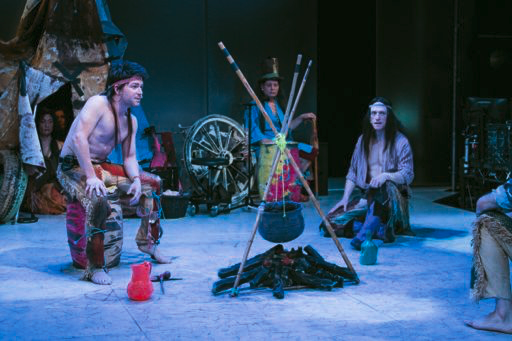
Figure 1. Koosil-ja as Andromache, Suzzy Roche as Cassandra, Ari Fliakos as Hector, Greg Mehrten as Priam, Scott Shepherd as Troilus, around the campfire. Photo credit Tim Hailand.
The haunting of Cry Trojans! is much more internalized, however: it is production not haunted by the weight of a theatrical historical past but by the companyʼs recent past, and recent failure. Even as Cry Trojans! mocks the intonations and performance styles of the RSC actors, it also feels like a performance of self-examination of the companyʼs methods and stakes, and its own status as an American theater company butting up against British theater traditions. It is the story of their encounter with the RSC or, indeed, a production haunted by their experience of voyaging back from the colonies to the metropole (or Stratford-upon-Avon).
Other forms of haunting are at stake in Cry Trojans! through the productionʼs engagement with its own “American-ness.” As they were in Troilus and Cressida, all Trojan characters are portrayed as Native American Indians. The stage, a thrust with audience on three sides, is white but for a ritual circle inscribed in the middle, while to the back is a ragged tipi. The costuming, designed by Dutch artist Folkert de Jong, is akin to the styling of a wild west show, with Kate Valk a pig-tailed Pocahontas-like Cressida. The Trojan armor, Styrofoam coats depicting quasi-classical nude male forms, reminds one of scalped and flayed skin, forms of violence long associated, in western minds, with Native American tribes. The actors fight with lacrosse sticks fitted with bayonets (not something that the NCAA or the MLL have adopted, thank goodness). The actorsʼ hopping movement, halting speech (which renders the text at point unintelligible), and propensity for chanting and atonal song, recall Tiger Lily in Peter Pan and all manner of offensive renderings of Native American "others" in Hollywood movies. A number of people (from drama critics, literary critics, and Native American advocacy groups) have pointed out, this is dangerous ground. As I write, baseball season is getting underway with news of protests at Chief Wahoo, the mascot of the Cleveland Indians, a movement that has got considerable media attention (and no little support). The Wooster Groupʼs depiction of Indianness or “Injun-ness” is not far from the “grinning face racism” of the Cleveland Indiansʼ mascot. The question is, to what end? Is the production a commentary on Native American appropriations (to some degree, yes) or a perpetuation of those appropriations (to some degree, also yes)?
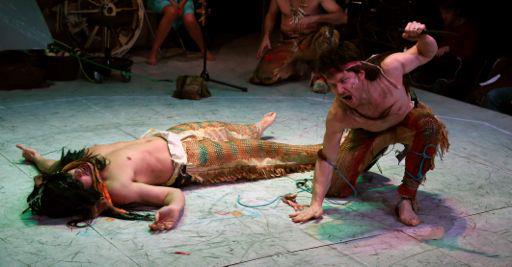
Figure 2. Casey Spooner as Ajax, Ari Fliakos as Hector, both dressed as Native Americans. Photo credit Paula Cort.
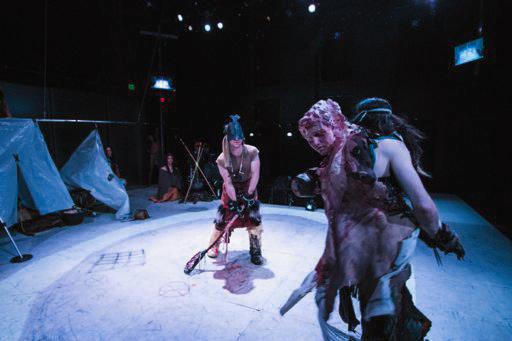
Figure 3. Suzzy Roche as Cassandra, Koosil-ja as Andromache, Ari Fliakos as Diomedes (carrying a lacrosse stick and wearing a black mask), Scott Shepherd as Troilus, wearing “body armor.” Photo credit Tim Hailand.
In the original collaboration, the RSC Greeks were clad in modern-day military fatigues, re-envisioning the plot of Troilus and Cressida as the struggle between an indigenous and invading force. This interpretation carries far less weight in Cry Trojans!, not least because of the absence of the RSC (the actors wear “primitive” black masks when they are playing Greek characters). Instead, the invading force is arguably the Wooster Group itself. That is certainly how they were seen during the collaborationʼs short run in Stratford and London in 2012, and to some degree this is how the Wooster Group positioned itself in the collaboration. De Jongʼs costume design of armor-as-classical statuary/corpse was one of many aspects of the production in which the Group positioned itself in relation to European culture, an approach that Steve Mentz, in a neat formulation, calls “extreme mediation” rather than outright antagonism in relation to their hosts, colleagues, and rivals. However, this is not the kind of invasion I am talking about here. If the RSC collaboration somewhat clumsily posited a colonizer-colonized dynamic within Troilus and Cressida, then Cry Trojans! seems (only somewhat inadvertently) to re-posit that dynamic within the Wooster Group itself.
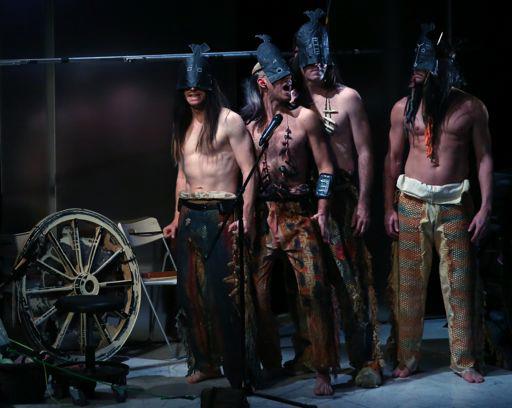
Figure 4. Scott Shepherd , Andrew Schneider, Gary Wilmes, Casey Spooner as the Greeks (Wilmes does not feature in the St. Anneʼs production). Photo credit Paula Court.
The Wooster Group has long played with American racial history and politics in its productions. An early production, Route 1 & 9 (1981) featured white actors in blackface running through "chitlinʼ" circuit routines, while more recently, the title character of Eugene OʼNeillʼs The Emperor Jones (2006) was played by company co-founder Kate Valk, likewise in blackface.3 The Wooster Groupʼs trouble with race has also been well documented: Route 1 & 9 was so controversial that the National Endowment for the Humanities (NEH) ceased to fund the company, although director Elizabeth LeCompteʼs casting choice in The Emperor Jones was, in New Yorker critic Hilton Alsʼs estimation, a far cannier choice, as it “makes it clear that Brutus Jones is a white manʼs idea of a Negro.” Cry Trojans! similarly makes it clear that these representations conjure white images of the Native American, with the Wooster performances emerging as bad approximations of Native Americans filtered through a history of white appropriation and representation. However, the immanent critique of OʼNeill (and by extension American theater) is less clear: OʼNeillʼs Brutus Jones may be “a white manʼs idea of a Negro,” but the Trojans are not Shakespeareʼs idea of any "other", Native American or otherwise.
The line that the Group walks, then, is between appropriation and the performance of appropriation. Staged by an experimental troupe with deep ties to the New York post-theatrical avant garde of Richard Foreman and Robert Wilson, the Wooster Group's work is underpinned by its engagement with the history of American cultural production, the ways in which it appropriates and cannibalizes pre-existing popular forms (of brows both high and low), and, in its more recent engagement with Shakespeare, how it relates to British cultural production as well. The post-theatrical tenor of these artists' work regularly tends back to ideas of primitivism, an inheritance which Cry Trojans! plays with directly by evoking “primitive” cultures (both Native American and, with the masks worn by the Greek characters, a notion of African “primitivism”).4 Yet in these engagements, the group, made up of an almost exclusively white acting company (Koosil-ja, who plays Andromache, is Japanese of Korean origin), comes dangerously close to perpetuating theft rather than ironizing and displaying it. If Als is right that the Groupʼs racial sensibilities have evolved over time in relation to its playing with blackface, we might not be quite so convinced by its engagement with “redface,” thus perpetuating the offensive “Injun,” and its subversive role in the history of the representation of Native Americans.
The companyʼs rationale for adopting Indian guise in Troilus and Cressida was, it seemed, that by bringing the Native American to British theater, they were also bringing what is quintessentially American as well. What, some might ask, could be more American than to "play Indian", to use this uncomfortable and potentially offensive childhood term? Philip Deloria has famously articulated the white American tendency to “play Indian,” which equates to dressing up as Native Americans in order to claim some form of indigenous American authenticity otherwise lacking in a nation made up of many immigrants. The Wooster Group itself seems unironically to have fallen under this tendency. In an interview quoted by Martin Harries in his critique of the production for the Los Angeles Review of Books, Kate Valk traced the origins of the decision to stage the Trojans as Native Americans as follows:
We were reading the play and I thought what was wrong with our reading was that we were pretending that we understood what we were saying. I just said, ‘Oh, we should say it like Indians,ʼ because I was thinking of English as a second language. I donʼt know, it just came to me. Itʼs not like having a problem to solve and wondering how we are going to solve it. It was just in the moment. I guess we all grew up on TV and film, an iconography of a formal relationship where someone has to come and meet not their oppressor, but someone who is more dominant.
Leaving aside Valkʼs own use of the suspect term "Indians," and his strange comment about the various Europeans with whom North American indigenous cultures are “dominant” but not “oppressors,” it becomes clear that the production choice was born out of the Groupʼs curious sense of inferiority to their Royal Shakespeare Company counterparts. Shakespeare seemed foreign to them (a strange statement for a company that has already taken on Hamlet). Moreover, the collaboration made them feel dominated by the British half of the collaboration, who speak (Shakespearean) English as a first language and hence have the linguistic advantage. Trying to speak the dominant language left the Group feeling “inauthentic,” because they realized that they did not understand what they were saying. To "say it like Indians," akin to "playing Indian," rendered the Group's experience of performing Shakespeare more authentic to them, an act of both claiming a dominant language and then appropriating it for their own purposes. To forge an authentically American take on Shakespeare, they embodied inauthentic representations of American indigeneity.
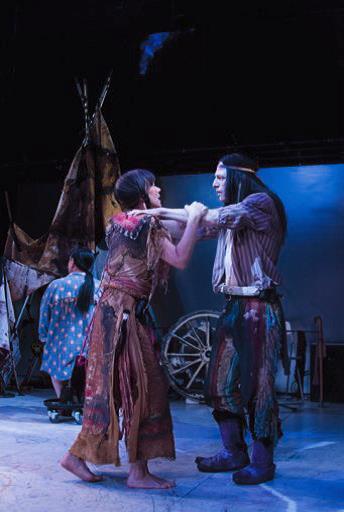
Figure 5. Greg Mehrten as Pandarus, Kate Valk as Cressida, Scott Shepherd as Troilus. Photo credit Tim Hailand.
The Wooster Group has consistently played with its own authenticity. Cry Trojans! is, above all, self-referential, a production about the Groupʼs “encounter with the RSC” and about its encounter with itself. As Bonnie Marranca argues, the Wooster Groupʼs “approach highlights process—the artwork and the work of art ... The Wooster Group takes to heart the idea of theatrical production and reproduction, offering both the performance and its documentation within the same event” (Marranca, 1, 6). The interplay between performance and documentation is evident in Cry Trojans! through the actorsʼ mimicry of scenes from films displayed on the screens. The love scene between Troilus and Cressida runs alongside scenes from Elia Kazanʼs melodrama of thwarted young love, Splendor in the Grass (1961), with Shepherd and Valk echoing the physical movements of Warren Beatty and Natalie Wood. The film returns later, when Cressida is forced from Troy into the Greek camp, with Valk intoning (in sync with Wood) “I just want to die,” many times over. Here the Group tap into the cynicism of Shakespeareʼs play. Playing the love scene between Troilus and Cressida alongside Splendor in the Grass highlights how doomed their love is (at the end of Splendor in the Grass both Beattyʼs and Woodʼs characters are married to other people).
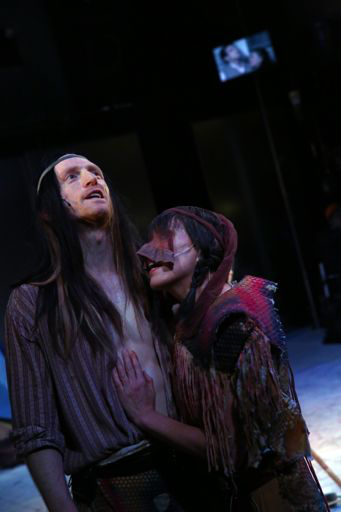
Figure 6. Scott Shepherd as Troilus, Kate Valk as Cressida, with Warren Beatty and Natalie Wood in Splendor in the Grass on the screen in the background. Photo credit Paula Cort.
Criticism of the collaborative Troilus and Cressida and of Cry Trojans! have noted (to quote Harries) how “The Wooster Groupʼs ‘native Americansʼ are native to the Hollywood screen.” However, most of the films employed to undergird much of the action of the production in its current iteration do not conform to the “iconography of the all-American Hollywood ‘Indian.ʼ” Much of the exaggerated, "Indianized" movements are modeled on both black and white and color ethnographic films (or “Salvage Ethnographies”) depicting Native American dances and rituals. The actors' impersonations of these movements ironize the claims of authenticity of these ethnographies, which were themselves presumably filmed in a bid to capture and preserve Native American “essence” for mass circulation. These same filmed ethnographies are, of course, constructs. The rituals they purportedly depict are conditioned by the form through which they were represented (the camera lens, the film screen), and by the attending structures that produced the film in the first place (the presence of camera crew, who not infrequently were the catalyst for the performance of ritual rather than being bystander eye-witnesses to such rituals). A similar problem afflicts many such ethnographic films, as evidenced by Tim Asch and Napoleon Chagnonʼs The Ax Fight (1975). The Wooster Group actors' bad impersonations mirror, therefore, the questionable authenticity of these ethnographic film constructs.
Other Cry Trojans! moments are punctuated with scenes from Smoke Signals (1998) and Atanarjuat: The Fast Runner (2001). Trojans carry basketballs with them, a visual echo of famous scene in Smoke Signals, while fight scenes and love scenes are paralleled with analogous moments from Atanarjuat. Even the swearing of fealty between Troilus and Cressida is punctuated with the duel scene from Atanarjuat, stressing how the playʼs language of love and violence are so closely intertwined. The sexual violence of violent sexuality in Troilus and Cressida is exposed through these choices, and becomes particularly effective in the first encounter between the two lovers, when Troilus hoists a distressed Cressida on his shoulders and runs around the camp-fire (yet another visual echo of a scene from Atanarjuat) just prior to Cressidaʼs famous question, “Will you walk in, my lord?”
The Wooster Group's pastiche is not of Hollywood-ized versions of Native Americans, but of Native American/First Nations self-presentation. Smoke Signals is often heralded as the first all-Native American film production; Atanarjuat is an Inuit film performed entirely in Inuktitut. Rather than comment on filmic appropriations so common to the Western genre, then, the Wooster Groups commits acts of appropriation, mimicking and arguably also mocking Native American cultural production, placing them at the same level as the questionably authentic depictions of Native American rituals of Salvage Ethnographies. It flattens out very different forms of Native American culture (rolling together Inuit and Spokane/Coeur dʼAlene peoples under the catch-all sign "Indian", or “Injun”). And it does so for an urban, elite, and almost exclusively white privileged audience.
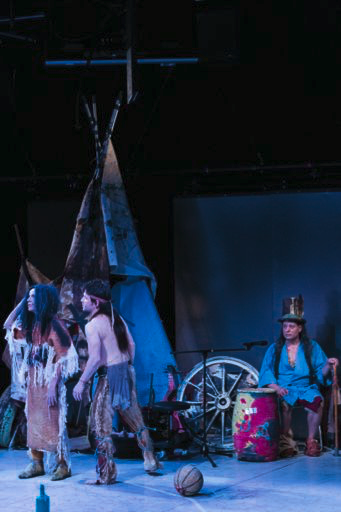
Figure 7. Suzzy Roche as Cassandra, Ari Fliakos as Hector, Greg Mehrten as Priam, and basketball (an allusion to Smoke Signals). Photo credit Tim Hailand.
The production not only mimics and flattens out indigenous North American cultures; it also seems to will their erasure. Troilus and Cressida ends with a sense of indeterminacy: Hector may be dead, but the war continues. The Trojan War itself was indeterminate—although defeated, the fallen Troy gave rise to the Roman Empire (and, in one mythic lineage, to a British one too). Cry Trojans!, without altering much of the closing language of the play, closes off any future for the Trojan-"Injun" characters. Troilus returns from battle with the Greeks naked but for a loincloth and a blanket. Stirred by his fellow Trojans, he returns to the field, flinging the blanket in disgust at the “broker lackey,” Pandarus. Pandarusʼ epilogue, in which he calls for “A goodly medicine for my aching bones” and “bequeath[s]” the audience “my diseases,” is the last of the playʼs many allusions to plague and sickness. In the context of Native American history, the coupling of this pox-ridden language with Troilusʼ blanket calls to mind stories of small-pox blankets distributed to Native Americans as a form of early biological warfare (at, for example, the Siege of Fort Pitt in 1763). Cry Trojans! ends, therefore, with an image of genocide, emphasized by Greg Mehrtenʼs Pandarus, who delivers the epilogue seated a wheelie chair at the back of the stage, before rolling off, leaving the space bare save for an empty tipi.
However, this concluding image of genocide is not born out by what we have seen in the play. At least in two senses in the production, indigenous North American culture does live, despite the historical and continuing deprivations leveled at Native American and First Nations peoples. Martin Harries is useful here:
The Wooster Groupʼs stance around race has always seemed savvy, but only up to a point: their performances mess with the stereotypes and other technologized clichés that contribute to Americaʼs racial logics. But after that point of savviness something often goes awry: having performed the ways inauthentic representations can nevertheless become effective, and damaging, they havenʼt been able to devise a theatrical response to the real force of these constructs.
I think Harries is astute here, but would argue that Cry Trojans!'s “awryness” does offer a theatrical response that underscores how the Groupʼs own play with “inauthentic performances” become effective in erasing the very cultures whose representation it seems to be wanting to ironize and complicate.
It would be one thing if the films the Group chose to mimic were just the “Salvage ethnographies,” or, for example, The Lone Ranger (Jay Silverheels is the likely inspiration for much of the actorsʼ portrayals)—that is, filmic appropriations of Native Americans that still have currency in Hollywood today (see Jonny Deppʼs turn as Tonto in the 2013 reboot).5 But mimicking Native American/First Nations cultural production and then pronouncing that culture dead by the end of the play squarely replicates the exploitation of Native American/First Nations culture, not only through the genocides of the sixteenth, seventeenth, eighteenth, and nineteenth centuries, but through the various appropriations in the twentieth and now twenty-first centuries of a so-called dead culture, much mourned by white American culture. Underlying much of the desire to “play Indian” is a sense of loss of a paradisiacal sensibility of innocence and an "at-oneness"with land and culture which is then transposed onto an Indian culture that can be replicated through various material processes, but which has to have been already lost. It is the manifestation for a nostalgia for what never was, as reimagined in a people who once were, but are no longer. Which is of course a nonsense: the "Indians" imagined in the act of "playing Indian" never existed outside the framework of a Euro-American imaginary, but actual Native Americans and First Nations culture exists.6
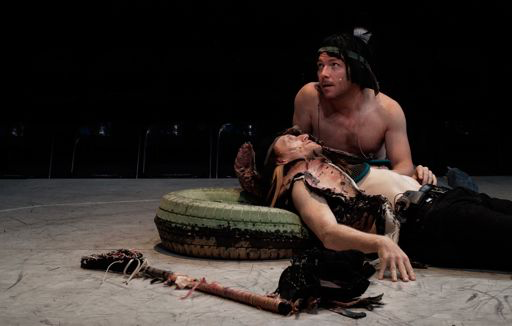
Fig 8. Scott Shepherd as Troilus, Ari Fliakos as Varlet, with car tire and lacrosse stick. Photo credit James Allister Sprang.
In his Indians in Unexpected Places, Deloria notes that, "[In] most American narratives [at the turn of the twentieth century], Indian people, corralled on isolated and impoverished reservations, missed out on modernity— indeed, almost dropped out of history itself. In such narratives, Native Americans would reemerge as largely insignificant political and cultural actors in the reform efforts of the 1920s and 1930s. World War II would force them to engage urbanism, wage labor, and American culture. Though such changes would nudge Indian people toward the modern world, their first and best chances at freedom, reason, equality, and progress had passed them by" (Deloria, 6).
Deloria rejects this prevalent thesis by turning to the “significant cohort of Native people [who] engaged the same forces of modernization that were making non-Indians reevaluate their own expectations of themselves and their society” (Deloria, 6). By contrast, The Wooster Group both ironizes and embraces this thesis, by displaying Native American engagements with modernity and subjecting them to a post-modern mimicry only to pronounce their erasure at the very end, on a stage set littered with the shredded tarpaulin and moss-covered car tires of a distinctly post-apocalyptic landscape. Here, then, the production "plays Indian" not only to play with actorly authenticity and the ghosts of theatrical encounter (with the RSC and with Shakespeare); it also highlights the destructiveness of so doing, by reducing native culture and history to a white, elite history of appropriation and genocide without positing alternative histories of resistance and/or re-appropriation (something which Smoke Signals in particular attempts to wrestle with by presenting and then ironizing certain Native American stereotypes). "Savvy," as Harries argues, but only up to a point. The Wooster Group seems to be aware of part of these appropriative formulations, and put on display both the work (their adoption of an Indian manner) and the work of art (the acts of appropriation that lead to their adoption of Indian manner). Nonetheless, for a company so invested in the ironies of post-modernity, The Wooster Group do not, in Cry Trojans!, seem so aware of the depth of their own unironic complicities.
References:
Als, Hilton. “The Empress Jones.” The New Yorker, March 27, 2006. http://www.newyorker.com/magazine/2006/03/27/the-empress-jones
Atanarjuat: The Fast Runner. Directed by Zacharias Kunuk, written by Paul Apak Angilirq, Norman Cohn, Zacharias Kunuk, Herve Paniaq, Pauloosie Qulitalik. Isuma, Igloolik Productions, 2001.
The Ax Fight. Directed by Timothy Asch and Napoleon Chagnon. Documentary Educational Resources, 1975.
Billington, Michael. “Troilus and Cressida – Review.” The Guardian, August 9, 2012. http://www.theguardian.com/stage/2012/aug/09/troilus-and-cressida-review
Hamlet Talkback with Scott Shepherd. http://thewoostergroup.org/blog/2012/10/12/hamlet-dublin-talkback-scotts-predicament/
Cartelli, Thomas P. “The Killing Stops Here”: Unmaking the Myths of Troy in the Wooster Group / RSC Troilus and Cressida (2012).” Shakespeare Quarterly, 64, no. 2 (2013): 233–43.
Deloria, Philip. Playing indian. New Haven: Yale University Press, 1999.
–––. Indians in Unexpected Places. Lawrence: Kansas University Press, 2004.
Harries, Martin. “The War in Troy Did Not Take Place: The Wooster Groupʼs Cry,Trojans!” Los Angeles Review of Books, February 27, 2014. http://lareviewofbooks.org/essay/war-troy-take-place-wooster-groups-cry-trojans/
Marranca, Bonnie. “The Wooster Group: A Dictionary of Ideas.” PAJ: A Journal of Performance and Arts, 25, no. 2 (2003): 1–18.
Mentz, Steve. “Cry Trojans by The Wooster Group,” April 11, 2015. http://stevementz.com/?s=cry+trojans
Smoke Signals. Directed by Christopher Eyre, screenplay by Sherman Alexie. Shadowcatcher Entertainment, 1998.
Splendor in the Grass. Directed by Elia Kazan, written by William Inge. NBI Productions and Newton Productions, 1961.
Notes
1 Cartelliʼs analysis of the critical opprobrium leveled at The Wooster Group is particularly
astute, as is his critique of the Groupʼs approach to the collaboration.
2 Interestingly, this line was not in the production when I saw it at the Performing
Garage in 2014. The Wooster Groupʼs shows constantly evolve—they hold open rehearsals
prior to mounting productions and even in the middle of productions.
3 For a video excerpt of Valk as Brutus Jones, see http://www.thewoostergroup.org/twg/twg.php?the-emperor-jones. For production photos of Route 1 & 9, see: http://thewoostergroup.org/twg/twg.php?route-1-and-9 (both accessed April 16, 2015).
4 The mission statement of Richard Foremanʼs Ontological-Hysteric Theater reads as
follows: “The Ontological-Hysteric Theater (OHT) was founded in 1968 by Richard Foreman
with the aim of stripping the theater bare of everything but the singular and essential
impulse to stage the static tension of interpersonal relations in space. The OHT seeks
to produce works that balance a primitive and minimal style with extremely complex
and theatrical themes”(http://www.ontological.com/history.html; accessed April 16, 2015; emphasis added).
5 Cartelli notes that the RSC collaboration included scenes from A Man Called Horse, and notes that Richard Harrisʼ costume seemed to influence de Jongʼs designs, but
this film seems to have fallen out of favor in the current iteration of Cry Trojans!. See Cartelli, 238 n 7.
6 The return of Cry Trojans! to New York coincided with an exhibition of Plains Indian Art at The Metropolitan
Museum of Art, which argues that Native American cultural production persisted even
through the mass relocations to reservations in the nineteenth centuries, and that
this lineage can be seen in contemporary Native American art. See http://www.metmuseum.org/exhibitions/listings/2015/plains-indians-artists-of-earth-and-sky (accessed April 16, 2015).